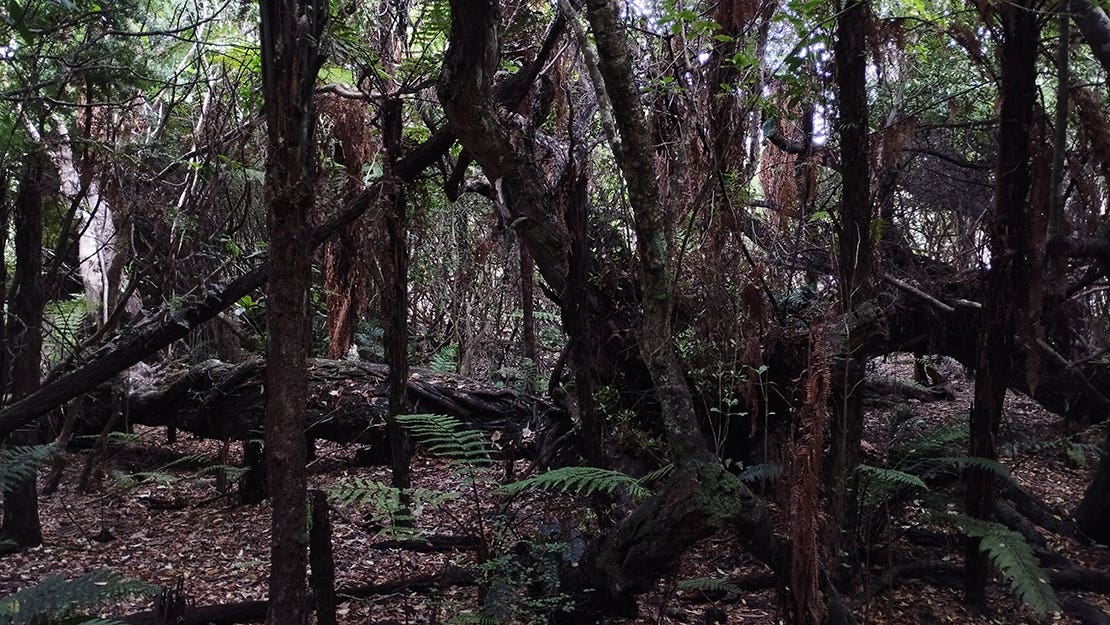It almost sounds like a mythic tale. On a small island of rugged coasts, swamps, and sheltered inlets, there dwells a mysterious silvery winged creature known as the Frosted Phoenix. Drawn from the dark to the light, the Frosted Phoenix rises and disappears throughout time, remaining unseen for over half a century.
This isn’t some ancient folklore or legend, but rather the story of 'New Zealand’s most enigmatic moth' — the extremely rare Titanomis sisyrota. Known as the Frosted Phoenix because of the ash-like pattern on its wings, Titanomis was long feared to be Extinct, though the IUCN Red List of Threatened Species had never assessed it. Only 10 specimens have ever been found, the last in 1959. With no scientific observations in at least 10 years, the Frosted Phoenix was considered a lost species by Re:wild’s Search for Lost Species. For decades, New Zealand’s small but dedicated community of moth experts has searched far and wide for the moth with nothing but a hunch that it was still out there.
That is until one unusually warm night in March of this year in Oban on Stewart Island, or Rakiura (‘glowing skies’) in Māori. Thanks to an unexpected and accidental twist of fate involving a UV light, a Swedish birdwatching tour guide, and the power of citizen science, the legendary Frosted Phoenix has risen again.
Stars aligning: a shot in the dark
Swedish biologist, naturalist author, and school teacher Pav Johnsson did not realize he would become the only living person known to have seen the Frosted Phoenix when he made the last-minute decision to travel to New Zealand and lead a birdwatching tour in March of this year. But in hindsight, the stars seemed to have aligned. From the spontaneity of the trip itself to Johnsson’s unique moth-spotting skills, pure luck met insect aptitude.
As a child in Sweden, Johnsson’s naturalist tendencies found fertile ground through support from his mother and a rich community of fellow nature lovers who formed the backbone of his social scene as a teenager. From collecting bugs in glass jars to going on weekend birding trips, Johnsson took part in a larger Swedish culture that participated and found joy in citizen science.
So it was no mystery why, before embarking on his New Zealand birdwatching journey, Johnsson packed his handy travel UV light to do some spontaneous moth-spotting.
When the birdwatching tour arrived in Oban on a windless, unconventionally warm night, Johnsson had an inkling.
“I knew that this particular night was a perfect night for moth viewing.”
Heading out to his second-story hotel balcony amidst a faint drizzle, Johnsson set up the UV light and headed out to embark on a late-night Kiwi spotting tour.
When he returned, he spotted a large, solitary moth beneath a chair on the balcony. Snapping some photos of those silvery, ashen wings, Johnsson headed to bed.
When Johnsson returned to Sweden and went through his photos, he came across the lone moth from that night in Oban, and couldn’t identify it. An avid user of iNaturalist, an online social network where people share biodiversity information, Johnsson uploaded the photos, marked them as unknown, and before long, the best of the internet got to work.
iNaturalist: a nature enthusiast’s happy place
Biologist or not, for those of us who tend to get a little bit nerdy when it comes to identifying and learning about biodiversity, iNaturalist can be somewhat of a happy place. Imagine a social network where photos of species, big and small, are uploaded and engaged with, a place where you can interact with fellow nature enthusiasts, discuss your findings, and, in the case of Johnsson, even have the chance to rediscover a lost species. A space where the comments section is full of enthusiastic observations and open, inquisitive dialogue, iNaturalist seems to be the rare online platform that restores your faith in the internet.
And it works too. Less than 24 hours after Johnsson made the post about the mysterious moth under his UV light on the island of glowing skies, a few expert moth-ers took notice. Before long, a comment came in that would change everything.
“No other living soul has seen this moth, the Holy Grail of NZ moths.”
The comment came from New Zealand moth expert Dr. Robert Hoare. An entomologist who has been searching for the Frosted Pheonix for 25 years, Hoare was the expert who gave Titanomis its charismatic name back in 2001 as an effort to raise local public awareness. Little did he know that a fellow insect admirer from halfway around the world would be the missing link to the rediscovery.
After Hoare’s expertise confirmed the rediscovery, moth-ers from around the globe, experts and amateurs alike, joined the conversation in the comments section of the post on iNaturalist, sharing their insights and congratulations.
“My experience with iNaturalist is that it’s quite allowing,” Johnsson says. "It’s ok not to be an expert… It’s a very open community, very warm. It’s not like some Facebook groups where people are really mean to one another. It’s a totally different angle, which I really appreciate.”
That’s also why iNaturalist and Re:Wild are working together to search for other lost species that may have been unknowingly rediscovered and posted to iNaturalist. You can track the progress in Re:wild's Search For Lost Species project on iNaturalist. So far we've surfaced over 150 candidates that may represent rediscoveries of lost species!
“Pav’s rediscovery is more evidence that we can’t do this alone— we need help from everyone around the world to find and protect lost species,” says Christina Biggs, Re:wild’s Lost Species program officer. “iNaturalist is a really great way for us to bring these efforts together and to mobilize an impressive network of committed citizen scientists, who are inspiring us.”
Citizen science: a growing community
The story of Pav Johnsson, the Frosted Phoenix, and the heartening online community of iNaturalist is a perfect example of the power of citizen science. Because when it comes to the work of people like Hoare in finding small, elusive insects, often there are simply not enough eyes on the lookout.
“I was mostly just lucky,” Johnsson says. “For me, the biggest thing is that I’ve accidentally led some biologists in a new direction that might contribute to research done on Rakiura. Also, that this might hopefully result in some protection in the future.”
Through platforms like iNaturalist, which amplify and harness the power of citizen science, we not only enhance our chances of discovery and rediscovery but also grow our community. Just as a young Johnsson found fellow nature enthusiasts in the forests of Sweden, fueling his passion for the unique species that captivate us, iNaturalist serves as a gathering place where people can learn, grow, celebrate, and contribute to biodiversity knowledge and conservation. It’s one of the many reasons why iNaturalist was recently honored with the Heinz Award for the Environment.
In a world of internet culture that can feel like it doesn’t always represent the best of us, the story of the legendary Frosted Phoenix rising again on its glowing island is a timely reminder of the unexpected ways building community around nature gives many of us hope and many more of us purpose.
Laura Moreno is a writer and communications specialist from the world of ocean conservation, working to share the stories that drive the protection and restoration of the wild. She is passionate about elevating the voices that inspire us from the front lines of conservation and exploring the species that remind us of the magic of what’s worth protecting.
When she’s not writing or looking at photos of nudibranchs, she spends her time surfing between one of two west coasts, California and Portugal, and digging for hidden sonic gems in record shops. Laura loves finding the right words, sounds, movements and music that make good stories come alive.




